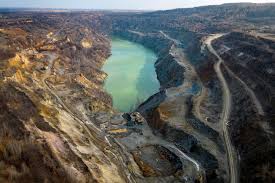
Irshank Experssepaper of Ukraine,
A huge lunar landscape of unnatural colors removes the winds above the frozen ground or a mechanical arm with mechanical arms. Titanium mining in Irshansk has more urgency than ever.
The huge machinery is sometimes operated by electricity, which is up to three hours daily. But resources such as titanium are potentially important for the deal of rare earth minerals that suddenly focus on peace talks in Ukraine. The signators of the deal, the United States and Ukraine, appear to oppose the interpretations of their terms, who leave several pruned details for later discussion.
Some existing and former US authorities have suspected President Donald Trump’s claim that the possible deal is on the verge of signing with Ukrainian counterpart Volodymyr Zelensky, which will provide the US easy access to a pile of rare earth minerals.
Whatever is present will be difficult to exploit, especially in times of war.
And from this mine in the North-Western city of Irshank, it is difficult to see how Ukraine can do; in this lifetime, half a trillion dollars can reach the dollar. Trump suggested that he may repay.
“Now we do not know what our work will be and how it will be,” the Ukrainian Congress said Dimtro Holik, director of mining and focused plant at DF.
“Every day we see how Ukraine’s energy system is being destroyed. Every day, the entire region is cut into an emergency, “he said, a reference to the waves of drones and missiles that pound Russian and Ukrainian houses and energy infrastructure each night.
The employees of the plant are mostly male, which is considered to be the titanium as an important industry. The possibilities are slow, and the benefits are low. “Our enterprise is very unstable now, and it
Opaque deal
The nature of the framework deal, according to a lesson seen by Experssepaper on Wednesday morning, to be signed by US Treasury Secretary Scott Besant and Ukrainian Foreign Minister Andry Sibiha, is opportune as industry elements that they want to exploit.
This refers to the half value of the “relevant Ukrainian government-owned natural resource property,” but says the specific details “will agree by both participants, as can be further described in the Fund Agreement.” The deal states that “the current source of revenue… already does not include part of Ukraine’s budget revenue.”
The limit of mineral funds in Ukraine is not clear.
The Ukrainian officials admit that they sometimes rely on geological dating from the Soviet era. Nevertheless, in a recent presentation by the Ministry of Ecology and Natural Resources, Kiev claimed 7% of the world’s titanium production and was 3% of the lithium reserves, which have not yet been mined. It was also said that Ukraine was among the top five countries with graphite reserves and rare earth minerals were deposited in tantalum, Niobium and berillium.
The figures are comparable to those who were written in the Ukraine chapter of 2020-2021 minerals by the US Geological Survey before Russia’s full-scale invasion, which disrupted production. At the time, the USGS stated that Ukraine was the fifth largest producer of graphite and the fifth largest producer of titanium sponges.
The USGS mineral commodity summary for 2025 did not include a figure for graphite reserves but, among other things, observed that Ukraine was a source of rare earth metal scandium and closed an alumina refinery that produced 1.7 million metric tonnes per year since 2022. “It is very difficult to talk about the actual value of these deposits,” Bariyatska said. “We can speak about the value of elements in the subcults, but we have to understand that there is a lot of investment to remove, process and sell them.

While the framework deal does not make it clear what property will be affected by any future funds, US National Security Advisor Mike Waltz gave a clear reference during the White House briefing for a Ukrainian “Aluminum Foundry” on 20 February.
“It is damaged; it is not at its current capacity; if restored, it will be responsible for the entire import of the US aluminum for the whole year,” Waltz said.
The White House did not respond to the request for clarification at the time of publication, and Waltz did not mention the foundry. But the most likely facility is that Japnorizhjia Industrial Aluminum Integrated Plant.
Mothball a decade ago, a video of the plant released by Ukrainian investigators in 2015 shows it in significant repair. According to a filing with Ukraine’s State Property Fund, it is currently working with much fewer employees and collided with a missile.
